Introduction
PrimaLuna is a Dutch-based company that released its first products, the ProLogue One and ProLogue Two integrated tube amplifiers in 2003. Then, in 2006, they released the ProLogue Three preamplifier, and ProLogue Five, Six, and Seven power amplifiers. Late in that same year, the PrimaLuna DiaLogue series hit the market, which had the ProLogue’s basic features, but with upgraded parts and additional capabilities. Here, we review the DiaLogue Seven, which is a monoblock power amplifier, capable of delivering 40 watts RMS in triode mode, and 70 watts RMS in ultra-linear mode (see The Design section for an explanation of what this means). The bottom line is that the PrimaLuna DiaLogue Seven monoblock is more than capable of delivering a clean, detailed, and lush sound (ah, those tubes are responsible for that).
Specifications
- Design: Class AB Tube Monoblock Power Amplifier
- Power Output: 40 Watts RMS into 8, 4, or 2 Ohms in Triode Mode, 70 Watts RMS in Ultra-linear Mode
- Tube Complement: Two 12AX7, Two 12AU7, Four KT88
- Frequency Response: 10 Hz – 100 kHz, ± 3 dB
- THD+N: 2% at Rated Output
- S/N: 89 dB Unweighted
- Input Impedance: 100 kOhms
- Input Sensitivity for Full Output: 1.1 Volts
- Inputs: One RCA
- Adaptive AutoBias
- Dimensions: 8.3″ H x 15.2″ W x 16″ D
- Weight: 64 Pounds
- MSRP: $5,499/pair USA
The Design
The DiaLogue Seven is a push-pull tube amplifier (monoblock – one channel), using KT88’s in the output stage. The input and buffer stages are handled by two 12AX7’s and 12AU7’s respectively. The 12AX7 and 12AU7 are native dual-triodes, high and medium voltage gains respectively, while the KT88’s are pentodes (actually, called a beam pentode). In a triode, there is a cathode, grid, and anode. The cathode is heated, which forms a cloud of electrons, and the positively charged anode (it has a “plate voltage” applied to it) attracts the electrons from the cathode. The grid, which sits between the cathode and anode, is a screen in form, so that the electrons can pass through. The music signal is applied to the grid, and its varying voltage allows more or less electrons to flow between the cathode and anode. The music signal voltage applied to the grid is very small, and the plate voltage is very large. The voltage and current flowing from the plate to the output transformer is, therefore, higher than the voltage applied to the grid, and voila, the signal has been amplified.
A single-ended tube amplifier uses one or more tubes that all handle the positive and negative portions of the waveform by being operated in Class A. In a push-pull design, such as the DiaLogue Seven, at least two tubes are used, with one tube primarily handling the positive portion of the waveform, while the other tube primarily handles the negative portion. There can be more than one tube for the positive and negative portions.
The DiaLogue Seven has four KT88’s. The tubes are biased such that they operate in Class A for a very small portion of the power. However, for most of the power, one pair handles the positive portion of the waveform (and some of the negative), while the second pair handles the negative portion of the waveform (and some of the positive). The amplifier never operates in Class B, which refers to one tube handling only the positive portion of the waveform, and the other tube handling only the negative portion. Operation in Class B produces crossover distortion. In Class AB, both halves of the output stage are operating when the output voltage swings from positive to negative, or negative to positive, until the other half has fully taken over.
Here is a diagram of a pentode. The numbers describe the parts of the tube: the cathode heater (1) has electrical current passing through it, which heats it directly, and then, this heat transfers to the cathode itself (2). By this method, you don’t get the heater voltage, which may be AC, introducing hum into the signal path. The control grid (4) is between the cathode (2) and anode (3), as are the screen grid (5) and suppressor grid (6). In the KT88, the suppressor grid is actually shaped like a tunnel, with electrodes on both sides, through which the electrons pass. The diagram shown here is “schematic” rather than illustrative of what the electrodes inside actually look like, or where the connecting pins are located.
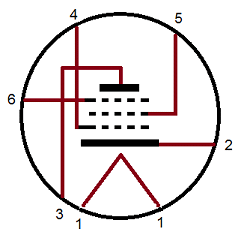
Here is a screen shot of a 1959 Genalex specification sheet (KT88, Issue 2, March, 1959), showing the schematic of the KT88 that they manufactured (copyright, Genalex). In this case, the pin numbers are indicated, which show how to connect the tube in a circuit.
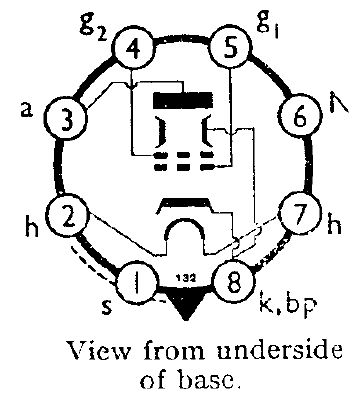
Many audiophiles love the sound of triode tubes. The DiaLogue Seven allows you to use the amplifier in “triode mode” or “ultra-linear mode”, by pushing a button on the included remote control (that is its only function). There is a small LED near the front of the amplifier that is green when in triode mode, and red when in ultra-linear mode. Switching the amplifier to triode mode connects the screen grid to the plate (only in the KT88’s). This reduces the maximum power output to 40 watts, compared to the ultra-linear mode, which connects the screen grid of the KT88’s to a point 43% in from the end of the output transformer that is connected to the tube’s plate. This increases the maximum power output to 70 watts RMS, and also serves as negative feedback, which flattens the frequency response.
The DiaLogue Seven adjusts the bias voltage on the control grid automatically, depending on the demands of the incoming signal. They call their version of this technique Adaptive AutoBias. The adjustment is on the order of a few milliamps, and is used to reduce distortion at high output levels. The process improves the sound quality, because there is now more current flowing that is routed to the output transformer (if this same amount of current were flowing at idle, it would be dissipated as heat, which wastes energy). The Adaptive AutoBias is only applied to the output tubes (the KT88’s). It also allows you to use different tubes, such as KT90 or 6550. A “Soft Start” feature slowly raises all of the voltages, including cathode heater and plate voltage, and this extends tube life.
Cross-coupled as well as local negative feedback are employed to reduce distortion, lower the output impedance, and flatten the frequency response.
While the signal path is handled by all tubes, the power supply is solid state.
The rear panel has one RCA input jack and four speaker binding posts, one for ground, and one each for 2, 4, and 8 ohms.
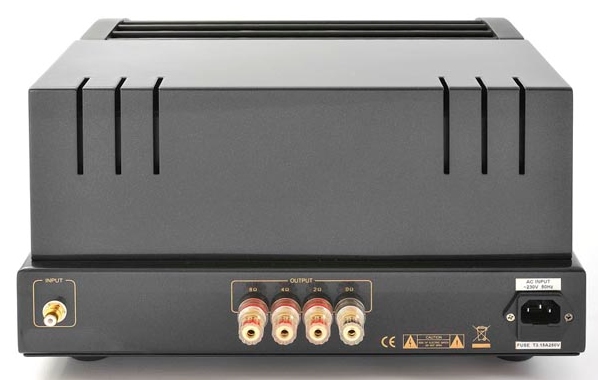
All in all, the build quality of the DiaLogue Seven is superb. The chassis is very heavy at 64 pounds (many multi-channel power amplifiers weigh about this much, and the DiaLogue Seven “only” puts out 70 watts).
In Use
I tested the two DiaLogue Seven monoblocks with an OPPO BDP-83 Special Edition universal player, Lamm L2 Reference tube preamplifier, and Paradigm Studio 20 v3 bookshelf speakers. Cables were Emotiva.
The Paradigm Studio 20’s are 8 ohms nominal, have a sensitivity of 90 dB, and are made for amplifiers in the range of 15 to 180 watts output, so I felt they were ideal for the DiaLogue Sevens.
Notwithstanding the speaker’s reasonable sensitivity, I had no illusions that 70 watts per channel, let alone 40 watts, would deal with the Jurrasic Park soundtrack. So, I chose music that I would realistically listen to with an amplifier of this modest power output. I used the 8 ohm taps exclusively for the listening tests.
In fact, that was no problem for me, as most of the music I listen to is classical chamber music and choir.
Mozart’s Piano Sonatas (Virgin Classics 5-099969-947322) was a good choice to start out with, because I love classical piano, and piano is a dificult instrument to reproduce.
Although in ultra-linear mode, there was more power (authority?) and snap to the sound, I preferred the triode mode. The more limited 40 watt output was still sufficient to give me a nice listening level, and the sound was richer. It seemed to have more softness rather than hard edged. This is typical of triodes, which have more low-ordered harmonic distortion. The highs as well as the deep lows (the lowest note on a piano is 28 Hz) seemed a bit rolled off, but that is no surprise, as it is just one of those things that tube amplifier output transformers tend to do (the tubes themselves are flat from DC to several megahertz). Not all tube amplifiers do this, as different design parameters (e.g., the amount of negative feedback employed) can flatten the response. Also, there are tube amplifiers that don’t use output transformers at all (called OTL, or Output TransformerLess).
But, the DiaLogue Seven was rolled off. The solution for me would be to add a subwoofer to handle frequencies below 50 Hz or so. I don’t like up front highs anyway, so the rolled off high frequencies suit me just fine. Realists would say this is not high fidelity, but the idea is to have a pleasant listening experience, and the DiaLogue Sevens delivered that to my satisfaction.
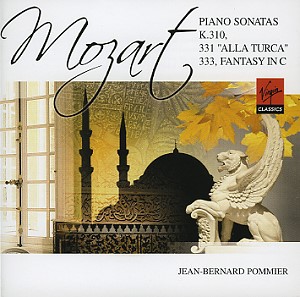
Classical choir is another of my favorite types of music, such as this SACD, entitled Solvguttene (2L42SACD). I reviewed the DiaLogue Sevens during the December holidays, and this recording is a Christmas album. Voices in particular, sound terrific with triodes, and the DiaLogue Sevens were no exception. Although the sound could “reach” farther in ultra-linear mode, I still preferred the triode mode, for its sweetness.
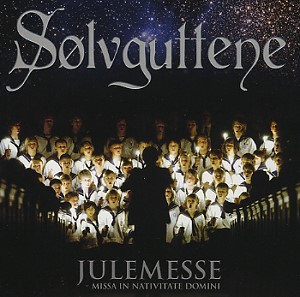
On the Bench
All distortion measurements were made within an 80 kHz bandwidth, at 5 volts output into 8 ohms unless otherwise specified.
At 1 kHz and 5 volts output into 8 Ohms, THD+N was 0.51% in triode mode (first graph), and 0.23% in ultra-linear mode (second graph).

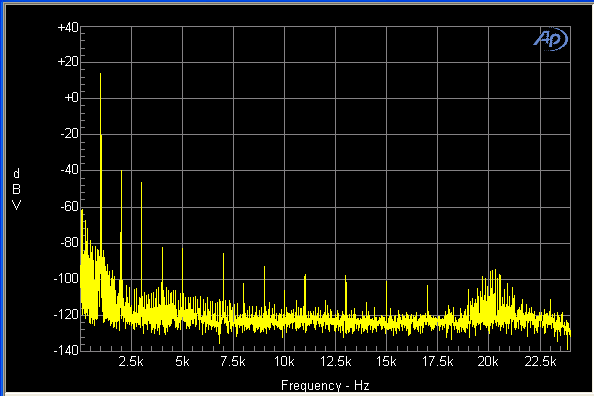
Using 19 kHz and 20 kHz sine waves, the B-A peak for triode mode was 42 dB below the harmonics (first graph), while in ultra-linear mode it was 51 dB below (second graph).
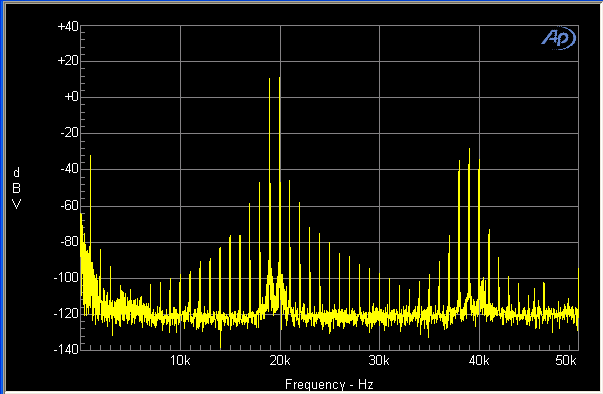
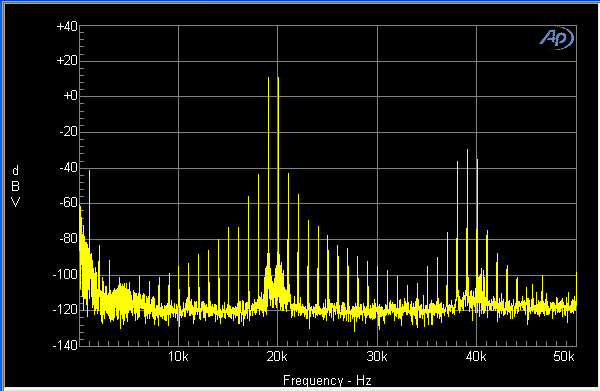
IMD, using 60 Hz and 7 kHz sine waves as the signal, was 2.1% in triode mode (first graph), and in ultra-linear mode (second graph), it was 0.92%. Notice, however, that the amount of 2nd order harmonics in relation to the fundamental (1 kHz) is higher in triode mode.
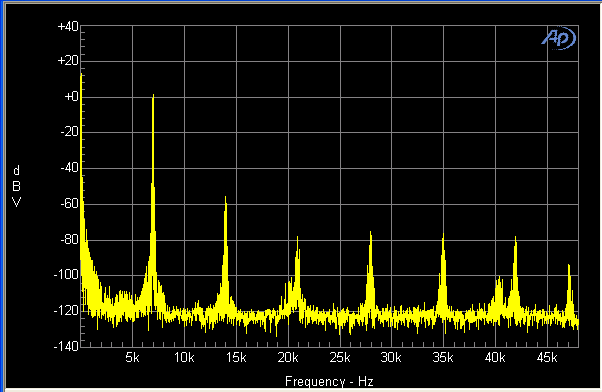
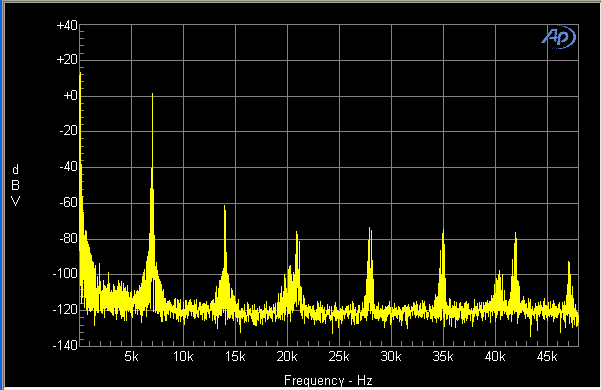
THD+N vs. Frequency at 5 volts into 8 Ohms is shown below. The yellow line represents triode mode, and the red line is ultra-linear mode.
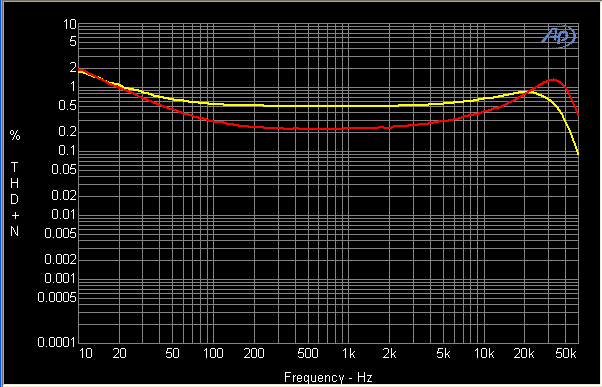
For THD+N vs. Power Output, I measured the DiaLogue Seven into 8 Ohms (first graph) and 4 Ohms, using the respective speaker taps on the rear panel. The yellow line is triode mode, and the red line is ultra-linear mode. Notice that the graphs are almost identical, which is what is supposed to happen when you match the binding post tap to the impedance of the speaker. Remember, however, that speakers are rated “nominally”, which means that the impedance varies with the frequency, so you might want to experiment using the different speaker taps with your speakers.
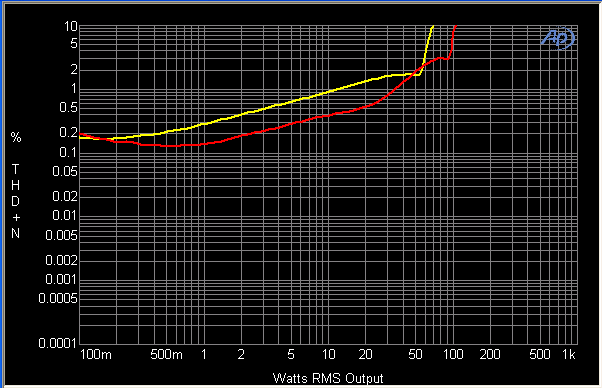
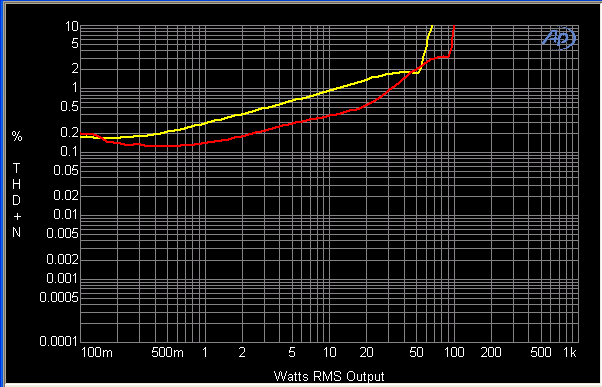
The measured frequency response between 20 Hz and 20 kHz, shown below for triode mode (yellow line) and ultra-linear mode (red line), indicates a 4 dB rolloff below 50 Hz for both modes, and a slight rolloff above 5 kHz for the triode mode. The response at 100 kHz is down 3 dB for triode mode and 1 dB for ultra-linear mode. Note that there is a rise in response for the ultra-linear mode between 20 kHz and 70 kHz, and then it declines, to peak sharply at 160 kHz. There is also a peak with the triode mode, but it is much less pronounced.
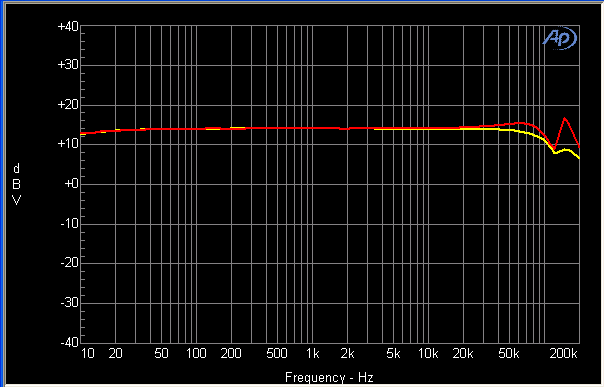
Conclusions
PrimaLuna’s products and sound were unfamiliar to me before this review. Now, they are familiar, and I like what I heard. If you are a tube-ophile, you also will like what you hear. If you are a purist, you will likely prefer the triode mode as I did, but there certainly was nothing wrong about the sound in ultra-linear mode. It was just “different”. This is not an inexpensive product by any means, but you get what you pay for, and in this case, you are paying for some great music listening.



